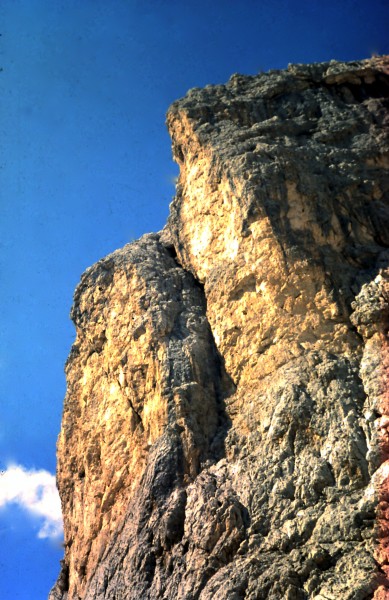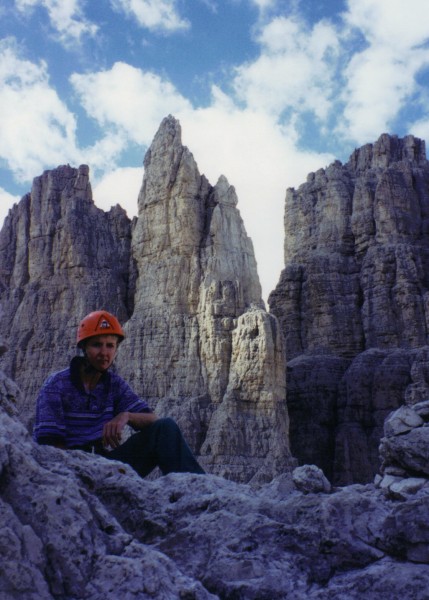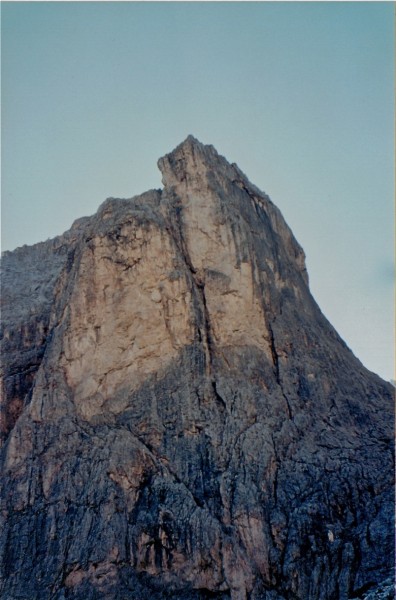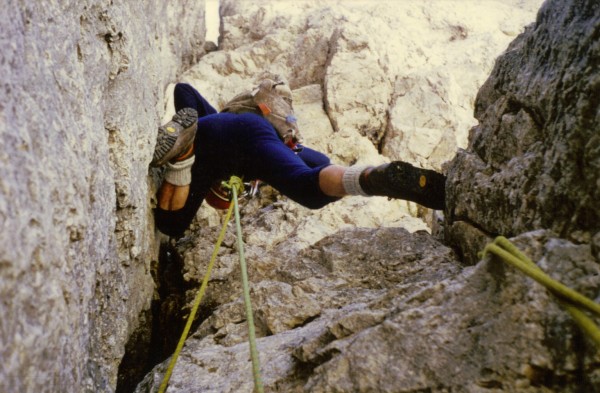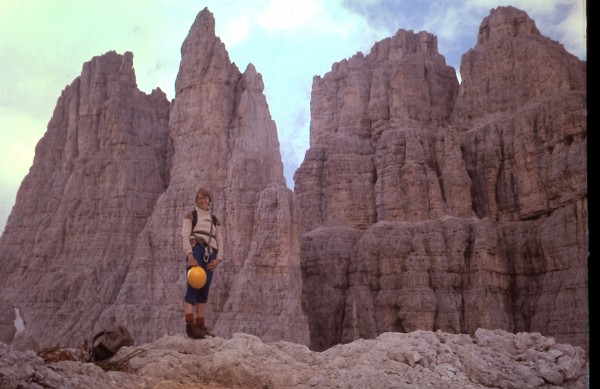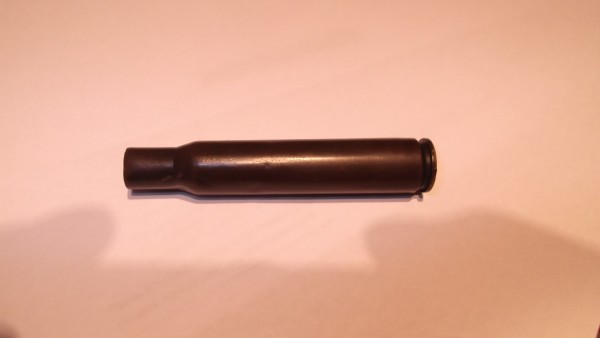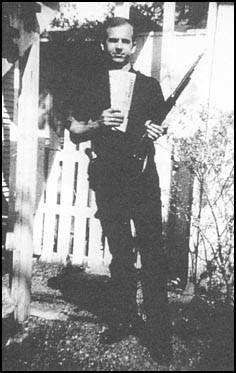Trip Report
Punta Emma - The 'Piaz Crack', Lee Harvey Oswald and the Kennedy Assassination
|
Thursday April 12, 2012 6:43pm
|
|
Punta Emma - The 'Piaz Crack', Lee Harvey Oswald and the Kennedy Assassination
'Uhh What!' A choss pile, Lee Harvey and Kennedy - How much tinfoil am I gonna need for this shyte?
Well - read on........ I first posted up this TR a while ago and writing it piqued my curiosity on the topic of World War One and how it was fought in the Dolomites, So I've editied the reort to include some other interesting stuff that I've researched.
Over the years my wife Bronwen and i have visited the Dolomites several times. on two occasions we have climbed Punta Emma, high in the Val de Vajolet, above the Vajolet Refugio. In the early 90s Bronwen. The routes on Punta Emma constitute a 'short day', and we have done two; the Steger/Wiesinger a stout 5+ (where one belay was held together by the rusting pegs and a few nuts).
Another 'short day' was to do the classic Piaz Crack on Punta Emma a seven pitch grade five soloed in 1900 by Tita Piaz, one of the Dolomites great pioneers.
Punta Emma sits close to the Vajolet Towers in the Rosengarten, above the Rifugio Vajolet. Nowadays accessed by bus I recall getting up to the hut on our bike, cabling the helmets to the motorbike before heading off across the slope to the base of the route.
The line of the route was strikingly obvious and followed the right facing corner for a couple of pitches before climbing the easier slabs on the left up to the summit.
Given the route was 'only' a grade five and was soloed in 1900, we decided to spice it up a bit by doing it in our 'big boots' and sacks. I at least had stiff soled alpine boots, but Bron was wearing some very bendy hiking shoes, which with hindsight were far from suitable.
It was a fine midsummers day when we set off, and we were soon at the base of the corner, the substructure being very moderate. It was a bit disconcerting to pass several memorial plaques to deceased climbers on the bottom pitches, the eyes of victims in the ceramically glazed photos seemed to size you up as you passed, but hey it was 'only' a grade five, so they must have all been chumps.
Anyhow, putting thoughts of impending doom (as best we could) behind us we reached the base of the corner. It turned out to be pretty steep, in fact it seemed to overhang somewhat, and had a vibrant stream running down it that fed a number of large green colonies of sphagnum moss like vegetation. But it was only a grade five sooo....
Off I went after 30' or so I got tangled up in the corner, the pro was classic Dolomites, vintage pieces of rust that struggled to take the weight of the krabs I clipped into them, There was little choice but to use the crack, but it was streaming with icey cold water draining from the deep freeze in the Punta's bowels. It was very, very unpleasant. I thrashed my way up it and eventually reached the sanctuary of a belay with my right hand numb and my sleeve a rather soggy green from battling with the moss.
Then it was Bronwen's turn. Bronwen never swears, and to her great credit she didn't, as she fought her way up the corner, slowly loosing the feeling in her right hand and with her feet skidding off the footholds in her bendy boots. She arrived at the belay a bit the worse for wear.
Up till now, this is just another climbing yarn, an adventure with all the usual climbing ingredients; uncertainty, errors of judgement, stout character and winning out. But as I belayed Bronwen up the pitch I noticed behind me a pile of spent cartridge cases on the ledge. Once she was up and had warmed her hands, I squeezed into the back of the chimney. About 20 cases littered a small area deep inside the chimney.
During the First World War the Italian and Austrian armies fought a bitter conflict in the Dolomites, and many famous climbers of the time were killed in the fighting. The position deep in the chimney offered a concealed vantage point that overlooked the path below. Amazing! I stopped up one of the spent cases and put it in my pocket.
Once we had warmed up we continued on our way and warmed up somewhat on the summit before doing the two raps down the back of the Punta to flat ground.
The only practical way for the sniper to have got to the firing point would have bee to have been lowered several hundred feet from the summit, presumably at night. There's no way it would have been approached from below as that would have been in view of whoever you were going to be shooting at later in the day.
Anyhow I kept the case for many years and eventually through the wonders of the internet made an effort to identify it. That would indicate the nationality of the sniper, and his targets.
Whilst it wasn't CSI, It didn't take long to come up with a strong match.....
 Missing photo ID#244286 Missing photo ID#244286
Which was of course the weapon used by....
While I would defer in my knowledge to the learned gun nuts on here, Piton Ron et al ;-) 'I rest my case M'lud'.
So tinfoil aside, as long as you believe (as I do) that LHO was the shooter, then you see how the title to this piece comes about. An adventure with both history and mystery; Piaz - what a stud soloing that in 1900, hats off to the Italian sniper who volunteered for that job, commiserations to his victims and well done us for getting up it (but it was only a grade five!). Just as well it wasn't a pile of grenades! And a handsome bit of Sherlocking to round it off (forgive the pun)
As I mentioned at the start, this has piqued my curiosity about the First World War in the Dolomites, and the internet makes it increasingly possible to carry out a range of basic research (though there's not much in English).
As a result I'm, pretty confident that my hypothesis is correct and that the summit was held by the Austrians. It seems that at the start of the war the Italians were somewhat slow off the mark, this gave the Austrian's time to mobilise their reserves; the Friewillige Shutzen and Tyrolean Standshutzen. In most instances they were able to occupy much key high ground. The Austrians also came into a significant number of the Manlicher Carcano, many were captured, however they also sequestered a significant number that had been manufactured for, but not delivered to Greece. So it is reasonably plausible that the sniper was an Austrian.
In addition there are a number of contemporary, strategic battle maps that indicate the area was likely under Austrian control. I have yet to find any equivalent s of a Western Front trench map - but they are probably out there....
Anyhow the map below shows the general situation is 1915 - 17 the enlargement shows the approximate FEBA (Forward Edge of the Battle Area) in and around the Cattanaccio. While it's far from conclusive I like to think it supports my view!
 Missing photo ID#337393 Missing photo ID#337393
Anyhow in addtion to this I stumbled across some other fascinating detail. I was aware that on that there were extensive trenchworks and galleries on and around the Marmolada, the highest peak in the Dolomites, which has it's own glacier. What I was unaware of was that the Italians held most of the 'rock', and constructed their defensive positions on and into the Limestone, while the Austrians tunneled into the glacier, constructing galleries, firing positions and accommodation deep inside the ice.
 Missing photo ID#337394 Missing photo ID#337394 Missing photo ID#337395 Missing photo ID#337395 Missing photo ID#337396 Missing photo ID#337396 Missing photo ID#337397 Missing photo ID#337397
The final surprising thing that I stumbled across was that when the Italian front collapsed, Britain and France sent several divisions each to support the Italians in the battle of Capporetto. In all 1024 British troops of the XIV Corps were killed in the campaign and over 5000 wounded. Those who were killed are interred at seven military cemeteries in northern Italy; Grennazza, Barenthal, Boscon, Magnaboschi, Dueville Montecechio, Precalcino and Giavvera.
There were also several American casualties, the numbers are so small that they were probably employed as observers, seeing what lessons could be learned about mountain warfare - but who knows...
I'm on a roll now and will continue to update this as and when I discover something of interest.
Steve
 Blakey
Blakey
|
 |
About the Author
Blakey is a trad climber from Newcastle UK. |
Comments
 couchmaster
couchmaster
climber
|
 |
|
|
Apr 12, 2012 - 06:49pm PT
|
Fantastic tale!!!!!
|
|
 Reilly
Reilly
Mountain climber
The Other Monrovia- CA
|
 |
|
|
Apr 12, 2012 - 07:35pm PT
|
OY, if it doesn't 'ave it all - choss, alpine daring-do, a fetching lass,
the barmy army, alpine history, more choss, and an 'appy ending sans tin foil.
Marvy, mate! But I think it more likely that if the sniper came in
from above he was more likely Austrian, especially seeing as it was
a Mannlicher.
|
|
 PellucidWombat
PellucidWombat
Mountain climber
Draperderr, by Bangerter, Utah
|
 |
|
|
Apr 12, 2012 - 10:02pm PT
|
Fun tale! And what a unique find! TFPU!
|
|
 guido
guido
Trad climber
Santa Cruz/New Zealand/South Pacific
|
 |
|
|
Apr 12, 2012 - 11:12pm PT
|
Nice TR treat!
|
|
 Toker Villain
Toker Villain
Big Wall climber
Toquerville, Utah
|
 |
|
|
Apr 13, 2012 - 12:34am PT
|
Well,........... it might be the 6.5x52mm Italian (Mannlicher-Carcano).
But what about the 6.5x54mm Schoenauer?
There is even a 6.5x53Rmm Mannlicher (less likely as it is Dutch and Romanian and your pic appears to be not rimmed)
Probably NOT a French 6.5x53.5mm Daudeteau.
Even less likely a 6.5x55mm Swedish Mauser.
(uh Blakey,.... that's a real nice photo of the case profile, but there is a little thing called a headstamp,.... you should inspect it)
|
|
 Blakey
Blakey
Trad climber
Sierra Vista
|
 |
|
Author's Reply
|
Apr 13, 2012 - 02:19am PT
|
Hey Ron,
Thanks for chipping in,
Herewith a shot of the headstamp it seems to say k 54
I think it's a 6.5mm Carcano, I guess I could measure across the rim where the round sat but it's a bit distorted.
Carcano was Italian, not Austrian was it not?
Whaddayathink?
Regards,
Steve
|
|
 bhilden
bhilden
Trad climber
Mountain View, CA/Boulder, CO
|
 |
|
|
Apr 13, 2012 - 03:20am PT
|
Heading up to do the Hexenstein on the Falzarrego Pass in the Dolomites I found an intact cartridge(casing and bullet). I still have it somewhere here at home. I will try to find it and post a picture.
|
|
 Brokedownclimber
Brokedownclimber
Trad climber
Douglas, WY
|
 |
|
|
Apr 13, 2012 - 09:07am PT
|
Somewhere in my "archives" (i.e. "junk pile") I have a spent projectile ("bullet" to the non-gun readers) that I found on my ascent of the Via Demuth on the Cima Ovest in 1964. From the size of the bullet, it too had to be a 6.5 mm Carcano. The whole area was one huge battleground; my partner, Lew Brown, and I got our clothes a bit ripped up on some old barbed wire coming down in the dark.
P.S. added in edit: it was too deformed to measure, but the weight was pretty light.
|
|
 Toker Villain
Toker Villain
Big Wall climber
Toquerville, Utah
|
 |
|
|
Apr 13, 2012 - 09:33am PT
|
Between speculation about the position belonging to an Austrian lowered from above and the 54 on the headstamp I would guess it is a 6.5x54 Mannlicher-Shoenauer.
BTW, in the 12th edition Barnes speaks highly of this cartridge comparing it to the .257 Roberts, but noting that the 160 gr loading gives superior penetration having 2140 foot pounds of energy.
After WWII the market was flooded with the Italian Carcano rifles, many of them had never been fired and only dropped once.
That is why Oswald could buy one so cheaply.
Barnes notes that the low working pressure limit prevents loading as heavily as similar military 6.5 mms. It was not a good rifle, but in the "wrong" hands,..
|
|
 Reilly
Reilly
Mountain climber
The Other Monrovia- CA
|
 |
|
|
Apr 13, 2012 - 10:30am PT
|
and only dropped once
HaHaHaHaHa!!!! Thanks, Ron, my day is off to a chortling start! :-)
|
|
 Ezra Ellis
Ezra Ellis
Trad climber
North wet, and Da souf
|
 |
|
|
Apr 14, 2012 - 11:38pm PT
|
Sweet piece of history!
Thanks
|
|
 Rick A
Rick A
climber
Boulder, Colorado
|
 |
|
|
Apr 15, 2012 - 09:48am PT
|
Steve,
Thanks for your recent threads, including this excellent one, a tale that blends climbing, climbing history, and real history spanning the Great War and the Kennedy assassination. The usual TR's pale in comparison!
The only time I visited the Dolomites was in August of 1976 with Mike Graham, and our goal was the North Faces of the Tre Cima. But the best laid plans of climbers oft are foiled by weather. When we woke up at the Lavaredo hut, this was the view that greeted us.
So we had some time and explored the nearby, World War I era fortifications. We found dark tunnels leading to machine gun nests, which had commanding views of the valley on the north side of the the Tre Cima.
|
|
 Blakey
Blakey
Trad climber
Sierra Vista
|
 |
|
Author's Reply
|
Apr 15, 2012 - 02:13pm PT
|
Thanks Rick, you're very kind
It's a small world you know, I and my climbing partner at the time - Les Morris (a Scot) were at Snells the summer you and Mike Graham were there. We bouldered, with you, Cubby, Murray and the rest!
I saw your photos of Mike G's 'big air' on the boulder - took me straight back to 76!
Also, we were in the Dollies last summer, you were likely on the Paternkoffel, well tunnelled out which looks back on the Tre Cime.
The tunnels eventually lead to a moderate Via Ferrata that takes you to the summit
Best regards,
Steve
|
|
 Rick A
Rick A
climber
Boulder, Colorado
|
 |
|
|
Apr 15, 2012 - 02:17pm PT
|
Steve,
Great to meet again, and to know that we shared some of our misspent youth together!
Not really misspent;in fact, that was living well quite well: a tent on Snell field with the Pierre D'orthaz a few steps away and the Mt. Blanc range around the corner. If you have any pictures from those days, post them up!
Hope to meet up again in person, someday. If you ever visit the states, let me know.
Rick
|
|
 Blakey
Blakey
Trad climber
Sierra Vista
|
 |
|
Author's Reply
|
Apr 15, 2012 - 02:22pm PT
|
I haven't any photos, but Les may have - he lives on Ibiza now. I'll sound him out, but looking at that last photo you may have an old green Saab 96 captured on film - If you have that was his!
Steve
|
|
 go-B
go-B
climber
|
 |
|
|
Apr 15, 2012 - 05:28pm PT
|
|
|
 Marlow
Marlow
Sport climber
OSLO
|
 |
|
|
Dec 18, 2013 - 12:57pm PT
|
A fantastic tale...
|
|
 RyanD
RyanD
climber
|
 |
|
|
Dec 18, 2013 - 01:11pm PT
|
What a cool TR. Climbing & Guns, something for everyone on supertopo.
The Dolomites really look magical.
|
|
 Brokedownclimber
Brokedownclimber
Trad climber
Douglas, WY
|
 |
|
|
Dec 18, 2013 - 09:41pm PT
|
There were over 50,000 casualties in the "Festungskreig" (Fortification war) between 1914 and 1918 in the area of the Falzarego Pass and Valparola Pass. Tunnels are everywhere, and many of the approach paths were originally constructed as military roads and mule supply trails.
|
|
 SteveW
SteveW
Trad climber
The state of confusion
|
 |
|
|
Dec 19, 2013 - 12:51am PT
|
It wuz the mobsters, I tell ya!!!!
|
|
 Reilly
Reilly
Mountain climber
The Other Monrovia- CA
|
 |
|
|
Dec 19, 2013 - 01:36am PT
|
This TR, like most of Blakey's, deserves to be pinned to the front page.
|
|
 Blakey
Blakey
Trad climber
Sierra Vista
|
 |
|
Author's Reply
|
Dec 21, 2013 - 11:29am PT
|
So,
The power of these threads and the internet…….
As a follow on to this TR, you'll see that Rick Accomazzo and I crossed paths back in 1976 in Chamonix.
Rick visited the UK this summer with his wife and visited Wales and the lakes where we were able to hook up for a route in Langdale's White Ghyll. A mere 36 years later!
For some reason the select photo button isn't working at the mo - I'll post a shot later when it's in a better mood!
Steve
|
|
 bhilden
bhilden
Trad climber
Mountain View, CA/Boulder, CO
|
 |
|
|
Dec 23, 2013 - 01:13pm PT
|
Here is a photo of some WWI artifacts I found while climbing in the Dolomites. The shrapnel was found on the Lagazuoi (Passo Falzarego) and is most likely from the Italian gun placements over at the Cinque Torri.
The completely intact rifle cartridge was found on the approach to the Hexenstein(also Passo Falzarego). The markings on the rim look like this:
U
19 09
BAF
The spent cartridge has the following markings:
BPD 73 then a circle with a + in the middle of it.
BTW, most of the over 60,000 troops who died in the fighting in the Dolomites during WWI were a result of the horrific winter conditions (avalanche, frostbite, hypothermia). It was so bad that near the end of the war both sides decided to suspend hostilities during the winter months.
Also, unlike WWII, the Italians fought for the Allies in WWI so the fighting was Austrians versus Italians. The Allies promised the Italians the Sud Tirol, which covers the Dolomites and was part of Austria at the time if the Italians fought for the 'good' guys.
|
|
 mouse from merced
mouse from merced
Trad climber
The finger of fate, my friends, is fickle.
|
 |
|
|
Dec 23, 2013 - 01:55pm PT
|
This is brass turned into gold, an alchemist at work.
The thing that I'm taking home from this unusual, dollied-up TR is the setting itself.
They were not fighting in trenches. They had their own set of problems.
The only ones happy in these valleys were the far-away munitions dealers.
And the Reaper.
Kudos for the lessons, and I really wanted to visit the Dollies in my twenties, but never got the call.
And many thanks for the tour, mate.
About JFK and Oswald: Colonel Mustard, in the bathroom, with an old rifle stock. Final answer.
|
|
 Blakey
Blakey
Trad climber
Sierra Vista
|
 |
|
Author's Reply
|
Dec 27, 2013 - 11:45am PT
|
So,
I've added some stuff to the original TR. If you have read it and found it interesting revisit it; there's more out there....
Steve
|
|
 Reilly
Reilly
Mountain climber
The Other Monrovia- CA
|
 |
|
|
Dec 27, 2013 - 12:49pm PT
|
Steve, no offense but your Point Emma casing doesn't look the same as
the one in the FBI photo. The angle at the neck doesn't look the same
to me. And the groove at the rear looks different too. I'm sure Ron
will sort it out.
Love the maps and cut-away drawing!
I'm going to be in the Tre Cima next fall. Do you know of any good
military sites there? I'm also wanting to get my porcine butt up the
Spigolo Giallo because it is a Comici route and it's a great line.
|
|
 Blakey
Blakey
Trad climber
Sierra Vista
|
 |
|
Author's Reply
|
Dec 27, 2013 - 05:08pm PT
|
Hi Reilly,
No offence taken, the photo of my cartridge is slightly distorted by the lens on my camera. When you compare the profile of the actual cartridge with the FBI photo they are pretty identical. Though I would happily defer to any experts opinion. Ron seems OK with the hypothesis....?
As to locations, well there are defensive positions on all sides of Tre Cime, and the Paternkofel, right next to it is a honeycomb of tunnels and strongpoints, it's a grand day hike with an easy Via Ferrata, there's some photos of it in my comments above.
West of and above Cortina there's some reconstructed trenchworks at Cinque Torri that overlook the Tofana de Roses. I think all of the significant cols and high points were probably fought over...So there's stuff everywhere. Back in the 70s on my first visit to Tre Cime we were finding old foot ware and utensils in the scree, because of the climate stuff didn't degrade the way it would elsewhere.
It would be really cool to do the Yellow Edge, or indeed anything up there, Other short routes on the sunny side are the Cassin on Cima Picollisima VII-, and around the corner the Preussriss/Preuss Crack V After that there's just the elephants in the room The Comici and Cassin on the respective North Faces. They are stunning.
|
|
 Blakey
Blakey
Trad climber
Sierra Vista
|
 |
|
Author's Reply
|
Jan 8, 2014 - 04:57pm PT
|
Fort Mental has started a thread...
http://www.supertopo.com/climbers-forum/2315115/Ropes-and-Guns-Mountains-at-War-in-World-War-1"]http://www.supertopo.com/climbers-forum/2315115/Ropes-and-Guns-Mountains-at-War-in-World-War-1[/url]
This provided a link which explains the deaths of the US servicemen I mention above. I had speculated that they were (because of their small numbers) likely performing a liaison function. A link provided by a contributor (Jim T) explains the Doughboys presence.
http://ww1ha.org/italianfront.htm
and
http://ww1ha.org/dbsitaly.htm
332 Inf Regt of 83 div were posted to Italy in July 1918, their role as described was to boost Italian morale and create the impression that a much larger contingent were being committed to the front. A range of deception operations were carried out and they participated in an offensive on the 24 October;
"On October 24th, the opening day of the Italian Vittorio-Veneto offensive, the Italian 31st Division with the 332nd Infantry attached was in reserve. It joined in the pursuit of the fleeing Austrians on October 29th as part of the British XIV Corps of the Italian Tenth Army; the American regiment forming the advance guard of the corps. On November 3, after several hard marches, the 332nd Infantry established contact with an enemy rear-guard battalion which was defending the crossings of the Tagliamento River near the village of Ponte-della-Delixia."
Steve
|
|
 Brokedownclimber
Brokedownclimber
Trad climber
Douglas, WY
|
 |
It was in this theater of war where a young infantry officer by the name of Erwin Rommel made his name known while winning the coveted Pour le Merite (known in Western circles as the Blue Max).
|
|
 mouse from merced
mouse from merced
Trad climber
The finger of fate, my friends, is fickle.
|
 |
|
|
Mar 22, 2018 - 03:29pm PT
|
Bumping a great Dolomites thread. It's really fun, Blakey.
Comin' back to the US anytime for a visit?
|
|
|
 |
 |
Recent Trip Reports
- The Kohala Ditch Trail: 36ish hrs on foot... to and from the headwaters. [5 of 5]
May 31, 2019; 11:57pm
- A Winter Traverse of the California section of the PCT Part 8
May 31, 2019; 11:18pm
- Supertopo,A trip report for posterity
May 31, 2019; 11:00pm
- Balch Fest 2013. Two Days in and Around and On The Flake. The Official Trip Report
May 31, 2019; 10:57pm
- TR: My visit to the Canoe
May 31, 2019; 10:24pm
- Death, Alpine Climbing, The Shield on El Cap
May 31, 2019; 4:07pm
- Andy Nisbet (1953-2019)
May 31, 2019; 2:11pm
- Drama on Baboquivari Peak
May 31, 2019; 1:19pm
- Joffre + The Aemmer Couloir: ski descents come unexpected catharsis [part 2]
May 31, 2019; 7:45am
- Lost To The Sea, by Disaster Master
May 30, 2019; 5:36am
- My Up And Down Life, Disaster Master
May 29, 2019; 11:44pm
- Halibut Hats and Climbers-What Gives?
May 29, 2019; 7:24pm
- G Rubberfat Overhang-First Ascent 1961
May 29, 2019; 12:28pm
- Coonyard Pinnacle 50 Years Later
May 29, 2019; 12:24pm
- Great Pumpkin with Mr Kamps and McClinsky- 1971
May 29, 2019; 12:02pm
- View more trip reports >
|






